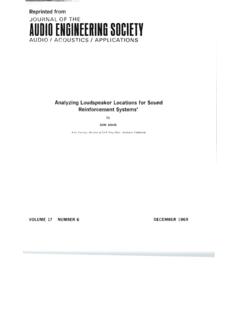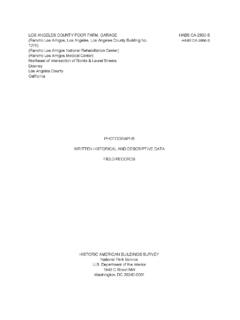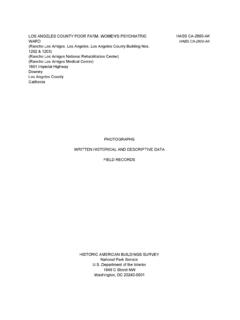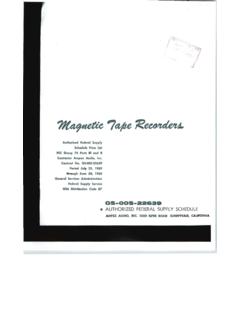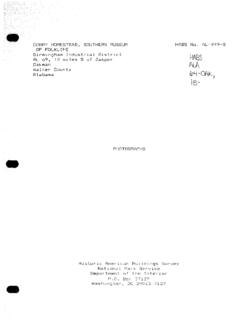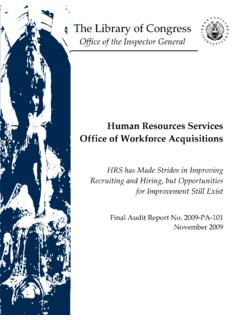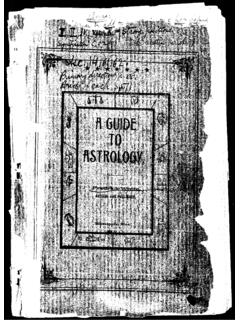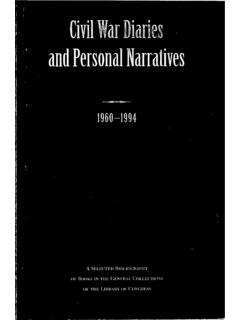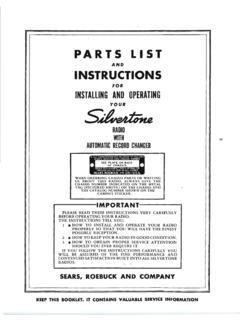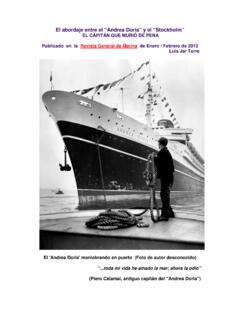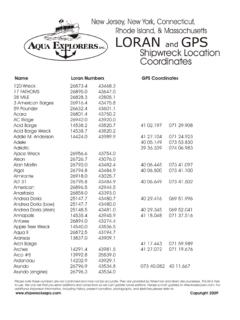Transcription of . U.S. Coast Guard Buoy Tenders, 180' Iris Class K Cape ...
1 Coast Guard CUTTER HORNBEAM HAER No. NJ-139. (WLB 394 , , WAGL394) M/-W v \. Coast Guard buoy Tenders, 180' iris Class K i \. Cape May vicinity '-' i Cape May County 5S _ Qs l"{: ,-,s . ^. New Jersey ~ '" , WRITTEN HISTORICAL AND DESCRIPTIVE DATA. HISTORIC AMERICAN ENGINEERING RECORD. National Park Service Department of the Interior 1849 C St. NW. Washington, DC 20240. HISTORIC AMERICAN ENGINEERING RECORD. MAETR. Coast Guard CUTTER HORNBEAM NJ, RIG/TYPE. OF CRAFT: Cutter ( iris Class ). TRADE: buoy tending (government). OFFICIAL NUMBER: WLB-394 (WAGL-394). PRINCIPAL. DIMENSIONS: Length: 180'. (As built) Beam: 37'. Depth: 12'. Displacement: 935 tons LOCATION: Curtis Bay, Maryland DATES OF. CONSTRUCTION: June 19, 1943 - April 14, 1944. DESIGNER: Preliminary design by United S. by Marine Iron and Shipbuilding Corporation of Duluth, Minnesota BUILDER: Marine Iron and Shipbuilding Corporation of Duluth, Minnesota PRESENT OWNER: Maritime Equipment and Sales, Inc.}
2 PRESENT USE: None SIGNIFICANCE: This vessel was built to serve as a 180' Coast Guard cutter. The federal government purchased or built thirty-nine of these vessels, built in three sub-classes, from 1942-1944. The '. Coast Guard (USCG) designed the 180s to service Aids-to- Navigation (AtoN), perform Search and Rescue missions (SAR), carry out Law Enforcement duties (LE), and conduct ice-breaking operations. Members of the Class have served in the USCG from 1942 to the present. They have significantly contributed to safe navigation on inland and international waters in times of peace and war. RESEARCHER: Marc Porter, 2002. Coast Guard CUTTER HORNBEAM. HAERNJ-139. (Page 2). PROJECT. INFORMATION: This project is part of the Historic American Engineering Record (HAER), a long-range program to document historically significant engineering and industrial works in the United States. The HAER. program is administered by the Historic American Buildings Survey/Historic American Engineering Record Division (HABS/HAER) of the National Park Service, Department of the Interior, E.
3 Blaine Cliver, Chief. The Coast Guard buoy Tenders, 180* Class Recording Project was sponsored by the Coast Guard , with Captain W. Patrick Lane, Chief, Office of Civil Engineering; Kebby Kelly, Environmental Officer; and Dr. Robert Browning, Historian serving as liaisons. The project was prepared under the direction of HAER Maritime Program Manager Todd Croteau. The historical report was produced by Marc Porter and edited by Justine Christianson, HAER Historian, NCSHPO. FOR ADDITIONAL INFORMATION ON THE Coast Guard buoy TENDERS, 180'. iris Class , SEE: HAER No. DC-57 Coast Guard buoy Tenders, 180' Class HAER No. DC-60 Coast Guard buoy Tenders, 180* iris Class . HAER No. AK-45 Coast Guard Cutter FIREBUSH. HAER No. AK-46 Coast Guard Cutter SEDGE. HAER No. AK-47 Coast Guard Cutter SWEETBRIER. HAER No. AK-48 Coast Guard Cutter WOODRUSH. HAER No. AL-199 Coast Guard Cutter SALVIA. HAER No. CA-309 Coast Guard Cutter BLACKHAW. HAER No.
4 FL-17 Coast Guard Cutter REDBUD. HAER No. GU-2 Coast Guard Cutter SASSAFRASS. HAER No. GU-3 Coast Guard Cutter BASSWOOD. HAER No. HI-61 Coast Guard Cutter MALLOW. HAER No. MA-152 Coast Guard Cutter BITTERSWEET. HAER No. ME-68 Coast Guard Cutter SPAR. HAER No. MI-323 Coast Guard Cutter BRAMBLE. HAER No. MI-328 Coast Guard Cutter ACACIA. HAER No. MN-98 Coast Guard Cutter SUNDEW. HAER No. NJ-139 Coast Guard Cutter HORNBEAM. HAER No. OR-118 Coast Guard Cutter iris . Coast Guard CUTTER HORNBEAM. HAERNJ-139. (Page 3). HAER No. PR-43 Coast Guard Cutter SAGEBRUSH. HAER No. TX-107 Coast Guard Cutter BLACKTHORN. HAER No. WA-169 Coast Guard Cutter MARIPOSA. Coast Guard CUTTER HORNBEAM. HAERNJ-139. (Page 4). Marine Iron and Shipbuilding built HORNBEAM for the Coast Guard and received $864,296 for the job. The yard laid HORNBEAM'S keel on June 19, 1943. She was launched less than two months later, on August 14. The Coast Guard commissioned the tender on April 14, 1944.
5 HORNBEAM'S initial tour of duty was as an AtoN tender and icebreaker on the Great Lakes. In July 1944 she left the Great Lakes for the Coast Guard 's 1st District and a new homeport in Woods Hole, Massachusetts. HORNBEAM served out the war in the waters around Cape Cod. Her primary duties were maintenance of the AtoN system. She was also used as a SAR. platform, as in an incident that took place in January 1945 when she went to the aid of the USCG. Cutter NEMESIS after the cutter collided with a merchant ship off Point Judith Light. Woods Hole remained homeport for HORNBEAM long after the war; she did not transfer to another duty station until July 1976. During the postwar years HORNBEAM carried out AtoN. work in an area of operations that stretched from Block Island to Nantucket. She also served as an icebreaker when the need arose, as it often did during cold New England winters. Besides servicing unmanned buoys, HORNBEAM regularly ferried personnel and supplies to five of the manned lightships marking the northeast Coast .
6 In 1954 HORNBEAM, using her powerful searchlights, even served as a lightship when the regular vessel was blown off station.'. As with most 180s HORNBEAM functioned as a SAR platform when trouble befell vessels in her territory. On the night of July 25, 1956, a maritime disaster unfolded 45 miles south of Nantucket Island. A series of compounding errors made on the bridges of the passenger liners andrea DORIA and STOCKHOLM placed the two vessels on a deadly collision course. A. few minutes after 11:00 the two ships collided at a high rate of speed on the edge of a fog bank. STOCKHOLM'S bow, reinforced for winter service in Scandinavian waters, was crushed, but the ship remained seaworthy. andrea DORIA did not fair as well. The collision resulted in the flooding of three watertight compartments, one more than andrea DORIA could withstand and remain afloat. Luckily for most aboard the sinking liner her demise would take several hours.
7 In the interim, a massive rescue operation by commercial, naval, and Coast Guard vessels managed to save 1,660 people from andrea DORIA. Fifty-one people perished in the accident, most of whom were on the andrea Doria. Of those fifty-one, most died as a direct result of the collision rather than as a result of the sinking. The final scene of the rescue played out as HORNBEAM arrived on the scene at 8:00 and rescued andrea DORIA's captain and approximately sixty of his crew from a lifeboat shortly before the liner rolled over and sank 1. Benjamin Ramsey, "Down East with the Hornbeam; Coast Guard Magazine Visits a Cape Cod buoy tender ," Coast Guard Magazine, March 1955, 15. Coast Guard CUTTER HORNBEAM. HAERNJ-139. (Page 5). to the HORNBEAM herself was not immune to the dangers of working along the frequently fog- shrouded Coast of New England. In May 1972 the tender collided with the Brazilian freighter DOCELAGO while operating in fog about 40 miles southeast of Nantucket.
8 The buoy tender suffered damage to the bow and well deck but faired far better than the andrea DORIA and made port under her own power. DOCELAGO escaped with little more than In 1962 HORNBEAM temporarily left her normal cruising grounds to participate in the shipping quarantine around Cuba. HORNBEAM and several small patrol boats dispatched from New England were involved in the operation that turned away several Soviet ships carrying offensive missiles intended for deployment in HORNBEAM undertook many SAR missions during her career but one of the most dramatic came in March 1971. The cutter received word that the GANNET, a fishing vessel, was in distress about 70 miles off Cape Cod. HORNBEAM was not on SAR standby, but her captain managed to recall the crew and get the vessel underway. The Coast Guard vessel pushed through thirty foot seas and hurricane force winds to reach GANNET. Upon rendezvousing with the fishing vessel, HORNBEAM passed a towline and towed the distressed craft to safety without any loss of HORNBEAM entered the yard at Curtis Bay in July 1976 for an extensive overhaul as part of the Major Renovation Program.
9 After the work reached completion in April 1977, the Coast Guard reassigned the cutter to Cape May, New Jersey where she was engaged in AtoN and SAR. work. The tender was decommissioned in September 1999 and stored at the Curtis Bay yard. The federal government subsequently sold her to a private corporation. As of January 2002, the former cutter was undergoing repairs that would allow her to depart the Curtis Bay yard. 2. Richard Goldstein, Desperate Hours: The Epic Rescue of the andrea Doria (NY: John Wiley & Sons, 2001), 54-56, 57,170-173, 281. 3. Ledger-Star (Norfolk), 26 May 1972, A9. 4. Wes Hall, Historical Context and Statement ofSignificance: Cactus, Mesquite, and Basswood Classes, United States Coast Guard 180-foot buoy Tenders (WLBs) (Castle Hayne, North Carolina: Mid-Atlantic Technology and Environmental Research, 1997), 16. 5. HORNBEAM Ship's History, HORNBEAM Cutter File, Coast Guard Historian's Office. Coast Guard CUTTER HORNBEAM.
10 HAERNJ-139. (Page 6). BIBLIOGRAPHY. Goldstein, Richard. Desperate Hours: The Epic Rescue of the andrea Doria. NY: John Wiley & Sons, 2001. Hall, Wes. Historical Context and Statement of Significance: Cactus, Mesquite, and Basswood Classes, United States Coast Guard 180-foot buoy Tenders (WLBs). Castle Hayne, North Carolina: Mid-Atlantic Technology and Environmental Research, 1997. HORNBEAM-Ship's History, HORNBEAM Cutter File, Coast Guard Historian's Office, Washington, Ledger-Star (Norfolk), 26 May 1972, A9. Ramsey, Benjamin. "Down East with the Hornbeam: Coast Guard Magazine Visits a Cape Cod buoy tender ." Coast Guard Magazine, March 1955.
